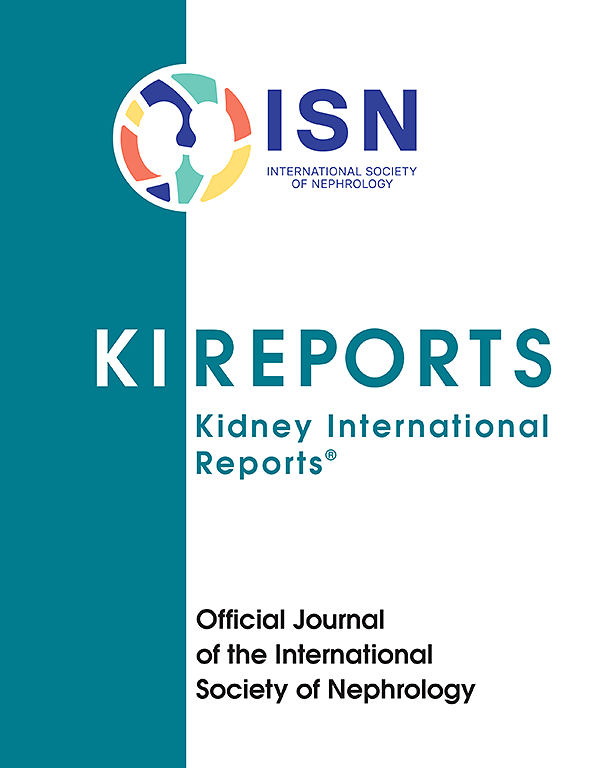Genotype-Phenotype Correlations in Denys-Drash Syndrome in Children
IF 5.7
2区 医学
Q1 UROLOGY & NEPHROLOGY
引用次数: 0
Abstract
Introduction
Denys-Drash syndrome (DDS) is a rare disease typically associated with a triad of early onset nephrotic syndromes (NS), susceptibility to Wilms tumor (WT), and genitourinary structural defects. DDS is caused by Wilms’ tumor suppression gene (WT1) variants, with the most frequent variants in exons 8 and 9. This study aimed to evaluate the long-term clinical outcomes and genotype-to-phenotype correlations in a large, multicenter cohort of children with typical DDS.
Methods
We conducted a national retrospective study of all children diagnosed with a pathogenic variant in WT1 exons 8 or 9 in France between 2000 and 2022.
Results
Fifty-eight children with DDS and variants in exons 8 (n = 23) and 9 (n = 35) of the WT1 gene were identified. Half of the children presented with NS (57% congenital, median age at presentation 0.3 years [interquartile range, IQR: 0.0–0.6]). Twenty-nine percent of children developed WT at a median age of 1.2 (0.5–2.2) years. Children with a variant in exon 8 developed NS much earlier than those with a variant in exon 9 (P = 0.0048), regardless of the type of genetic variation, leading to earlyier kidney failure (KF) (0.3 vs.1.4 years respectively; P = 0.0001) and higher mortality (35% vs 9%, P = 0.02). More than 90% of the truncating variants were located in exon 9 and were significantly associated with the occurrence of WT compared with the DNA-binding-site variants (P < 0.0015).
Conclusion
In our cohort, children’s DDS clinical trajectory was associated with exon localization. In the era of genomic newborn screening, depicting genetic risk is of utmost importance for personalized patient care.

儿童Denys-Drash综合征的基因型-表型相关性
denys - drash综合征(DDS)是一种罕见的疾病,通常与早发性肾病综合征(NS)、Wilms肿瘤易感性(WT)和泌尿生殖系统结构缺陷有关。DDS是由Wilms肿瘤抑制基因(WT1)变异引起的,最常见的变异是外显子8和9。本研究旨在评估典型DDS儿童的大型多中心队列的长期临床结果和基因型-表型相关性。方法:我们对2000年至2022年在法国诊断为WT1外显子8或9致病性变异的所有儿童进行了一项全国性回顾性研究。结果共检出58例DDS患儿,WT1基因外显子8 (n = 23)和9 (n = 35)变异。半数儿童表现为NS(57%为先天性,发病时中位年龄0.3岁[四分位数间差,IQR: 0.0-0.6])。29%的儿童在中位年龄为1.2岁(0.5-2.2岁)时患上WT。无论遗传变异的类型如何,具有第8外显子变异的儿童比具有第9外显子变异的儿童更早发生NS (P = 0.0048),导致更早的肾衰竭(KF)(分别为0.3年和1.4年;P = 0.0001)和更高的死亡率(35% vs 9%, P = 0.02)。超过90%的截断变异位于外显子9,与dna结合位点变异相比,与WT的发生显著相关(P <;0.0015)。结论在我们的队列中,儿童DDS的临床轨迹与外显子定位有关。在基因组新生儿筛查的时代,描绘遗传风险对个性化患者护理至关重要。
本文章由计算机程序翻译,如有差异,请以英文原文为准。
求助全文
约1分钟内获得全文
求助全文
来源期刊

Kidney International Reports
Medicine-Nephrology
CiteScore
7.70
自引率
3.30%
发文量
1578
审稿时长
8 weeks
期刊介绍:
Kidney International Reports, an official journal of the International Society of Nephrology, is a peer-reviewed, open access journal devoted to the publication of leading research and developments related to kidney disease. With the primary aim of contributing to improved care of patients with kidney disease, the journal will publish original clinical and select translational articles and educational content related to the pathogenesis, evaluation and management of acute and chronic kidney disease, end stage renal disease (including transplantation), acid-base, fluid and electrolyte disturbances and hypertension. Of particular interest are submissions related to clinical trials, epidemiology, systematic reviews (including meta-analyses) and outcomes research. The journal will also provide a platform for wider dissemination of national and regional guidelines as well as consensus meeting reports.
 求助内容:
求助内容: 应助结果提醒方式:
应助结果提醒方式:


